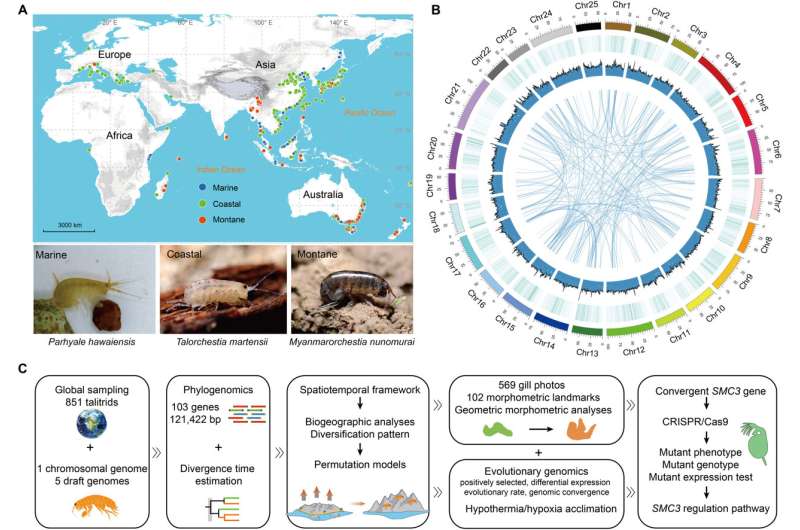This article has been reviewed according to Science X's editorial process and policies. Editors have highlighted the following attributes while ensuring the content's credibility:
fact-checked
peer-reviewed publication
trusted source
proofread
How talitrids advanced from sea to mountain: The legend of a terrestrial crustacean

Researchers led by Profs. Hou Zhonge and Li Shuqiang from the Institute of Zoology of the Chinese Academy of Sciences have revealed the morphological and genetic changes that occurred when animals evolved from a marine environment to a terrestrial lifestyle. The study was published in Science Advances on June 23.
In evolutionary history, animals gained certain advantages when they left the sea and began to explore land. However, with these advantages came inevitable challenges.
In order to examine the marine-terrestrial transition and resulting biological adaptations, the researchers investigated talitrids, a group of small crustaceans that live in a variety of regions and habitats, including the ocean, along the coast, and in mountainous areas. They used cutting-edge genome-wide data to understand how talitrids evolved.
According to the researchers, talitrids originated in the sea and independently colonized mountain habitats at least four different times during the Oligocene and Miocene periods. The movement of tectonic plates and the formation of volcanic islands played a significant role in this transition, leading to the diversification of talitrid species in mountainous areas. These new habitats became centers of high biodiversity, with many endemic species unique to these regions.
During land colonization, talitrids developed specific genetic adaptations (convergent variations) related to their breathing organs (gills) and energy metabolism. These adaptations helped them survive in colder environments and establish themselves in different habitats around the world.
The researchers also used a gene-editing technique called CRISPR-Cas9 to confirm that a specific gene called SMC3 was responsible for the observed changes in the shape of the talitrids' breathing organs, similar to changes in structures found in other crustaceans.
Overall, their study advances our understanding of the biological origins of marine organisms and provides valuable insights into how talitrids evolved and adapted to life on land, and how genes regulated their ability to survive in different environments.
More information: Hongguang Liu et al, Marine-montane transitions coupled with gill and genetic convergence in extant crustacean, Science Advances (2023). DOI: 10.1126/sciadv.adg4011
Journal information: Science Advances
Provided by Chinese Academy of Sciences



















